
1. Installation Steps, 2. Essential Equipment, 3. Professional Assistance, 4. Finalizing Connections
Installation Steps: The foundation of successfully installing solar panels hinges on meticulous planning and execution. 1. Site Assessment is paramount, where a team evaluates the location for optimal sun exposure, free from obstructions such as trees or buildings. Factors like roof condition, size, and angle are scrutinized to determine the best placement. By considering these elements, a more efficient solar energy system can be established, maximizing energy production. 2. System Design comes next, where the configuration of solar panels and other components is tailored to meet the energy needs of the space. This typically involves calculating the number of panels required based on consumption data and system efficiency.
Essential Equipment: The success of a solar panel installation significantly relies on specialized tools and components that ensure functionality and durability. 1. Solar Panels themselves are the most critical element, with various types available, including monocrystalline, polycrystalline, and thin-film. The choice of panel affects efficiency and cost, thereby influencing the overall quality of the installation. 2. Inverters are also vital, as they convert DC electricity produced by the solar panels into AC electricity usable in homes or businesses. Selecting high-quality inverters ensures longevity and consistent performance.
Professional Assistance: Engaging professionals for solar panel installation is often beneficial, providing expertise and efficiency that can enhance the process. 1. Hiring Certified Installers guarantees that the installation complies with local codes and regulations. Certified professionals possess the requisite knowledge and skills to handle complex installations, ensuring safety and reliability. This expertise often leads to a more efficient installation process, reducing potential errors and delays. 2. Financial Considerations must also be assessed when contemplating professional services. Investing in qualified personnel might seem costly initially but can lead to long-term savings through optimized system performance and maintenance.
Finalizing Connections: The closing phase involves connecting the solar panel system to the electrical grid and ensuring operational readiness. 1. Grid Connection is vital for utilizing generated energy effectively, allowing households to draw power from the grid when necessary and supply surplus energy back, often resulting in financial benefits. The process requires meticulous coordination with local utility companies to ensure adherence to protocols and standards. 2. Testing and Monitoring are critical steps post-installation. Rigorous testing ensures that all components function correctly and safely. Additionally, ongoing monitoring is essential for assessing system performance, addressing issues promptly, and optimizing energy production.
WHAT ARE THE ADVANTAGES OF INSTALLING SOLAR PANELS?
The advantages of incorporating solar panels into residential or commercial spaces are numerous and impactful. 1. Environmental Benefits stand out prominently; solar energy is a clean and renewable resource that significantly reduces reliance on fossil fuels, thereby decreasing greenhouse gas emissions. This transition contributes to a healthier planet, addressing essential climate change challenges. 2. Financial Savings also play a crucial role. By generating their electricity, homeowners can lower their energy bills and boost their financial savings over time. Many regions offer incentives and rebates that further enhance the affordability of installation, making it economically appealing.
HOW DOES A SOLAR INSTALLATION PROCESS WORK?
Understanding the solar installation process is essential for anticipating what’s involved. Initially, a systematic survey assesses a location’s potential for solar energy capture, factoring in elements such as orientation, shading, and available space. Following the assessment, a comprehensive design is crafted, detailing the array layout and equipment specifications. The installation phase includes mounting the panels on rooftops or on the ground, connecting wiring, and integrating inverters. Finally, a grid connection is established, leading to a testing phase that ensures all components operate efficiently before the system becomes fully operational.
WHAT MAINTENANCE DO SOLAR PANELS REQUIRE?
Maintenance of solar panels is crucial for ensuring their longevity and optimal performance. Regular inspections are recommended to check for dirt or debris accumulation that could hinder energy capture. Typically, solar panels require minimal maintenance; however, cleaning may be necessary, especially in areas with high dust or pollen levels. Over time, components such as inverters may need to be replaced or repaired. Keeping a consistent check on the system’s output and performance can detect anomalies early, allowing for timely interventions to maximize efficiency.
In summary, the routines associated with the installation of solar panels encompass a variety of structured steps that are pivotal for ensuring efficiency and sustainability. The journey begins with a thorough site assessment and system design, followed by undertaking the installation process with specialized equipment like solar panels and inverters. Professional assistance can enhance both the quality of installation and long-term savings, ensuring safety and compliance with necessary regulations. Finalizing connections entails integration with the grid and rigorous testing to guarantee optimal operation. Investing in solar technology not only fosters energy independence but also champions an environmentally friendly approach to energy consumption. By comprehensively examining all of these steps, individuals and companies alike can make informed decisions regarding solar panel installation, ultimately leading to a brighter, more sustainable future. Understanding the benefits, addressing maintenance needs, and recognizing the importance of professional service can transform the way energy is generated and consumed, helping to pave the way toward a more responsible energy landscape for upcoming generations.**
Original article by NenPower, If reposted, please credit the source: https://nenpower.com/blog/what-are-the-routines-for-installing-solar-panels/


